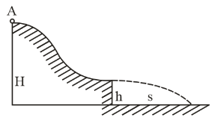A small body of mass is located on a horizontal plane at the point . The body acquires a horizontal velocity . Find,
The mean power developed by the friction force during the whole time of motion, if the friction coefficient , and ,
The maximum instantaneous power developed by the friction force, if the friction coefficient varies as , where is a constant, and is the distance from the point .

Important Questions on PHYSICAL FUNDAMENTALS OF MECHANICS
The potential energy of a particle in a certain field has the form , where and are positive constants, is the distance from the centre of the field. Find,
the value of corresponding to the equilibrium position of the particle; examine whether this position is steady,
the maximum magnitude of the attraction force; draw the plots and (the projections of the force on the radius vector ).
In a certain two-dimensional field of force the potential energy of a particle has the form , where and are the positive constants whose magnitudes are different. Find out,
whether this field is central,
what is the shape of the equipotential surfaces and also of the surfaces for which the magnitude of the vector of force constant.
A small disc slides down with initial velocity equal to zero from the top of a smooth hill of height having a horizontal portion. What must be the height of the horizontal portion to ensure the maximum distance covered by the disc? What is it equal to?

